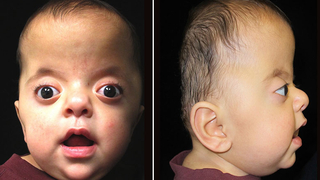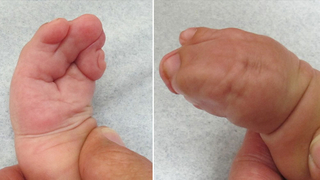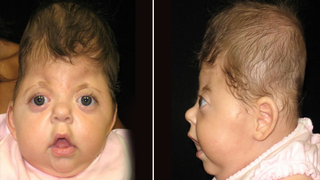What is Apert Syndrome?
Apert syndrome, also called acrocephalosyndactyly, is a genetic syndrome characterized by anomalies of the skull, face and limbs. Gene mutations are responsible for causing the early fusion of the skull, hand and feet bones.

Individuals with Apert syndrome typically have the following conditions:
- Craniosynostosis: early closure of one or more of the seams between the skull bones causing an abnormal skull. This results in a skull shape with increased vertical height.
- Midface hypoplasia: decreased growth of the midface. This causes a crescent moon or sunken facial appearance with depressed nasal bridge and beak nose. Decreased growth of the central face can contribute obstructive sleep apnea and airway concerns.
- Syndactyly: fusion of the fingers and toes. The hand can resemble a spade, mitten or rosebud.
Other common characteristics include large elongated forehead, shallow eye sockets causing prominent eyes, narrow palate with or without a cleft, fused bones in the arms, elbows and hips, and hearing loss. The characteristic feature that distinguishes Apert syndrome from other types of syndromic craniosynostosis is the presence of hand anomalies, most commonly fused or webbed fingers (syndactyly).
| Type I ("spade") | Type II ("mitten") | Type III ("rosebud") | |
| First webspace | Simple syndactyly | Simple syndactyly | Complex syndactyly |
| Middle three fingers | Side-to-side fusion with flat palm | Fusion of fingertips forming a concave palm | Tight fusion of all digits with one conjoined nail |
| Fourth webspace | Simple and incomplete syndactyly | Simple and complete syndactyly | Simple and complete syndactyly |

Apert syndrome complications and treatment
Patients with Apert syndrome can have related health and developmental issues, reinforcing the need for coordinated, multidisciplinary care and access to a variety of pediatric subspecialists.
At CHOP we have a comprehensive Craniofacial Program where patients are seen by the following specialties:
- Plastic surgeons: craniofacial and hand surgeons
- Oral surgeons
- Neurosurgeons
- Otolaryngologists (ear, nose and throat specialists)
- Pediatric dentists
- Craniofacial-trained orthodontists
- Geneticists
- Speech and language pathologist
- Audiologist
- Psychologists
- Advanced Practice Providers – NPs and PAs
- Nurses
- Pulmonary and Sleep Medicine

4-month-old female with Apert syndrome. Note the retruded brow and flattened forehead as well as sunken appearance of the face from the middle of the eyes to the upper jaw.
The treatment of Apert syndrome is dependent upon both functional and appearance-related needs, and should be addressed immediately after your child is born. Because of the complex issues that can be associated with Apert syndrome, your child should be treated at a medical center where she will have access to pediatric specialists across the many clinical areas she may need.
At Children’s Hospital of Philadelphia, coordinated care of patients with Apert syndrome is typically managed through the Craniofacial Program. At CHOP, our experienced Craniofacial Surgeons will help guide your child through craniosynostosis repair and other surgeries to address symptoms related to airway, dental/jaw relationships and craniofacial relations. Referral to a specialized hand surgeon with expertise in treating and repairing hand deformities is an important element of care for children with Apert syndrome. The Hand and Arm Disorders Program at CHOP is the region’s largest multidisciplinary center treating children with congenital deformities of the hand.
Children with Apert Syndrome benefit from routine psychosocial support to address any behavioral, developmental, academic, emotional or social difficulties associated with their condition, appearance differences, and surgical treatments throughout childhood.
Additionally, our Craniofacial Team maintains close collaboration with Genetics, Ophthalmology, Speech, Otolaryngology (ENT), Audiology and Neurosurgery to help provide comprehensive craniofacial care.
Families also benefit from specialized programs such as CHOP’s Center for Pediatric Airway Disorders and the Division of Pulmonary and Sleep Medicine to address breathing issues, as well as the Pediatric Feeding and Swallowing Center to manage feeding issues.
Watch our educational video to learn more about the services and treatment options CHOP offers to children with craniofacial conditions such as Apert syndrome.
Resources to help
Apert Syndrome Resources
Craniofacial Program Resources
We have gathered resources to give you information and help you find answers to your questions. We hope this makes your family's life a little easier.
Reviewed by Scott P. Bartlett, MD, Jesse A. Taylor, MD
